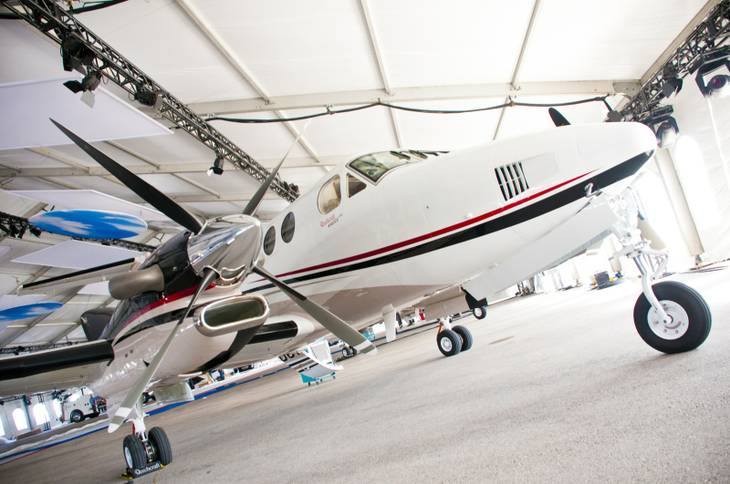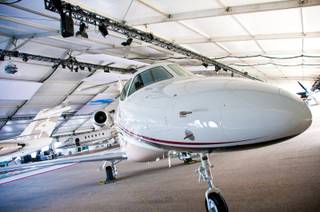Related stories
Sun Topics
Owners of corporate aircraft are breathing a little easier this week after the Senate dropped a proposal to add a $100-per-flight fee on business planes that had been part of President Barack Obama’s American Jobs Act tax plan targeting the wealthy.
The proposal generated buzz at last week’s National Business Aircraft Association conference in Las Vegas, where aviation industry leaders said the fee in Obama’s bill would have destroyed the economics of operating some models of corporate jets with low costs.
“It’s clear that the bully pulpit is being used to bully an industry,” said Dan Hubbard, a spokesman for the organization, during the association’s gathering. “Do we think we’ve been singled out and selected for punitive treatment? Yes.”
But after the Senate stripped the provision by the end of the three-day conference Wednesday — and Senate Republicans followed by blocking the entire bill and submitting their own legislation for consideration — industry officials and aircraft owners said rejection of the additional fee couldn’t have come at a better time for the industry.
Although the economy and roller-coaster ride of fluctuating fuel prices have buffeted aviation companies and limited growth, some segments have seen improvement over last year. What’s more, supporters of business aircraft said the industry would continue to pay its fair share of taxes through federal excise taxes on either fuel or the transportation of persons or property. For commercial transportation, passengers and jet owners pay a 7.5 percent tax, a domestic segment fee of $3.70 or $16.30 on international departures and arrivals and $8.20 on flights to and from Hawaii or Alaska. The latter two are up 20 cents and 10 cents, respectively, from 2010.
For noncommercial transportation, the fuel tax varies on aviation gasoline and jet fuel.
“The Senate appears to have been consistent in its position on user fees,” Hubbard said after the conference concluded. “We learned about it when it was proposed, heard about it in hearings and it was debated on the House and Senate floors and dismissed as a bad policy idea.”
Analysts said the proposal, which would have applied to both jets and turboprop aircraft, would effectively have put a 20 percent cost increase on the operation of some small jets, particularly the recently introduced Eclipse 500, Cessna Mustang and Embraer Phenom 100.
The move in the Senate came around the time the National Business Aircraft Association and the 26,000 people who attended its conference were beginning to shut down the trade show, which next year will move to Orlando, Fla. Dozens of corporate jets were on display at Henderson Executive Airport during the show and, for the first time, some small jets, planes and helicopters were shuttled to the Las Vegas Convention Center for display. The association maintained a bus shuttle between the Convention Center and the Henderson airport all week.
Those who stood to gain from the Senate’s actions included Cleveland-based Flight Options LLC, one of the companies that exhibited at last week’s conference. Flight Options, which operates a fleet of more than 100 jets and more than 1,300 owners and program members, reported a 33 percent increase in sales for the first nine months of 2011 over the previous year.
One of the company’s five maintenance centers is based in Las Vegas.
The company has seen minimal growth in Las Vegas operations over last year. For the first six months of 2010, Flight Options had 359 operations at three Southern Nevada airports — McCarran International Airport, Henderson Executive and North Las Vegas. In 2011, over the same six-month period, there were 372.
Irwin Helford, a Las Vegas resident and former chairman and CEO of Viking Office Products, also had a stake in the issue. He is a believer in one of the areas in which the industry is growing — fractional ownership, in which customers purchase air time in a plane instead of an entire aircraft. He acquired a fractional ownership seven years ago when his company was in talks to merge with Office Depot.
“People buy corporate aircraft or fractionals for a couple of reasons,” Helford said. “One is that you can fly right into small communities that don’t have an international airport. You can fly to multiple cities in one trip. But the big reason is time. By flying directly into small communities and on your own schedule, you save a lot of time.”
Helford believes the measure to sock aircraft owners was more political posturing by Obama than revenue generating.
“Now that I’m retired, I’m not in that million-dollar-plus salary level that Obama wants to tax so heavily. So it would be an additional burden to me. I’ll live with it, but not be happy about it,” Helford said before the Senate action.
No longer in business, Helford said he is unable to take tax deductions or accelerated appreciation advantages, but he feels the work of the foundations he serves — and using jets to get to meetings — is important enough to continue flying.
He serves on a board dedicated to cancer research and chairs another that maintains the Great American Songbook, a collection of jazz and Broadway music considered important to American culture.
Even after he retired, Helford opted to continue his fractional investment because of the convenience to him and his family in his philanthropic work.
“It’s all about QTR — quality time remaining,” Helford said. “There’s nothing more important to me than time. It’s more important than money and more important than pleasure and because of the comfort, safety and convenience, I have my family use private aircraft as well.”
Helford did a cost analysis to determine whether it made more sense to acquire an aircraft or go the fractional route. Eventually, he determined that flying by private jet was more economical than flying commercially, and because he didn’t want to have to maintain a jet and acquire a hangar, he went with fractional ownership.
Helford is just one of dozens of corporate aircraft operators in Las Vegas.
Officials at McCarran don’t have a database of corporate aircraft because it leases space to private fixed-base operators, the largest of which are Signature Flight Support and Atlantic Aviation, which have direct relationships to the companies. The base operators assist a tight-knit community of aircraft owners who generally shy away from publicity after some media representatives have targeted them as examples of corporate greed.
Amstat, a New Jersey-based aviation market research company, said there are 76 companies that own and maintain aircraft at McCarran, Henderson and North Las Vegas, and their fleets are composed of 149 planes.
Several casino companies maintain aircraft fleets, used both to transport executives and important customers.
MGM Resorts International has its own aviation department maintaining its fleet of corporate jets. Wynn Resorts advertises a private jet package for guests.
Las Vegas Sands Chairman Sheldon Adelson’s corporate fleet includes a Boeing 747, and Phil Ruffin, chairman of Treasure Island, has an extended-range Boeing 737 corporate jet.
The corporate planes support a small-business aviation niche in Las Vegas, which includes a family-owed company called Start Pac, which manufactures and sells ground power units, the portable battery devices used to start aircraft engines.
Eve Storm, vice president of Start Pac, said the company relocated to Las Vegas from Page, Ariz., and now sells 24 products, including a lithium ion battery that can be used to start train locomotives as well as airplanes.

